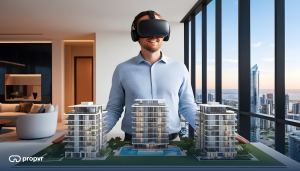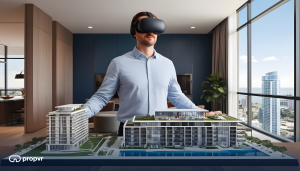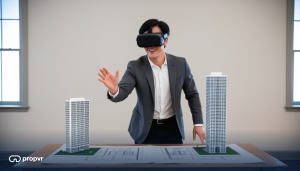The real estate industry is experiencing a rapid technological transformation driven by integrating digital twin technology and virtual reality (VR). Digital twins—virtual replicas of physical assets—reshape how properties are designed, managed, and experienced. PropVR is leading this revolution, merging digital twin technology with immersive VR experiences to offer unprecedented insight and interaction, transforming how properties are marketed and sold.
Bringing Properties to Life with Digital Twins and Virtual Reality
Traditionally, property development has relied on static physical models and blueprints. However, digital twins and VR are dynamic tools that evolve in real-time, reflecting every aspect of property development. PropVR allows developers, architects, and property managers to bring projects to life virtually, offering an immersive experience beyond simple visualization.
Digital twin technology provides a comprehensive view of a property’s current and future potential by incorporating data from sensors, IoT devices, and other sources, while VR technology lets buyers explore these properties as if they were physically present.
Use Case: Real-Time Monitoring and Management
Imagine a commercial building with a digital twin on PropVR’s platform. Property managers can monitor everything from energy consumption to occupancy levels in real time. With VR, potential buyers or tenants can virtually explore the property and experience its layout and functionality before deciding. This not only improves the management process but also shortens the property sales cycle, significantly boosting operational efficiency and customer engagement.

Revolutionizing the Property Design Process with Digital Twins and VR
The design phase in real estate can be complex, but PropVR’s digital twin and virtual reality solutions simplify this process by offering a virtual testing ground. Developers can experiment with layouts, materials, and design elements, receiving real-time feedback. Using VR, architects and stakeholders can take virtual walkthroughs, testing and refining every design detail.
Use Case: Virtual Prototyping and Design Exploration
Before committing to a design, developers can create virtual prototypes using PropVR’s digital twin technology, combined with VR walkthroughs. This enables detailed exploration of different design options, structural elements, and materials. Changes are instantly visualized, speeding up the design process and leading to better-informed decisions.

Enhancing Stakeholder Collaboration through VR
One of the most significant advantages of digital twins and VR is their ability to enhance stakeholder collaboration. From investors to contractors, all stakeholders can access and interact with the digital twin and VR simulations. Virtual reality provides an interactive environment where all parties can explore the property, address issues, and make informed decisions based on real-time data.
Use Case: Interactive Virtual Reality Stakeholder Meetings
PropVR enables stakeholders to hold interactive virtual meetings in the digital twin environment, which is complemented by VR. Instead of static presentations, stakeholders can explore the virtual property together, improving communication and streamlining decision-making.

Transforming Real Estate Sales and Marketing with VR Technology
Marketing properties traditionally involved brochures, photos, or physical tours. However, the integration of VR has revolutionized real estate marketing strategies. With VR, potential buyers can explore properties remotely, experiencing the space as if they were physically present, which boosts customer engagement and shortens the sales cycle.
Use Case: Virtual Property Showrooms
PropVR’s digital twin platform, combined with VR, enables the creation of virtual property showrooms that potential buyers can explore from anywhere in the world. These immersive showrooms allow buyers to customize spaces and view real-time property performance data. VR-driven tours and showrooms offer early buyer engagement, making the property buying process more engaging and efficient.

Boosting Property Sales with VR Technology
The integration of VR can significantly accelerate the property sales process by offering a more engaging, immersive experience for buyers. With virtual reality, buyers can visualize properties, test layouts, and make decisions faster, reducing the time spent on traditional visits and viewings. VR technology can thus help real estate agents attract more potential buyers and boost property sales.
The Future of Real Estate Management
As properties become more complex, the need for advanced management tools grows. PropVR’s integration of digital twins with VR offers a future-proof solution for property management, allowing managers to oversee every aspect of the building’s operation from a single platform. VR’s real-time visualization and predictive maintenance capabilities ensure properties operate efficiently and sustainably.
Use Case: Predictive Maintenance and VR-Driven Management
Property managers can implement predictive maintenance strategies by analyzing data from the digital twin and experiencing the property through VR. By predicting when equipment is likely to fail, managers can perform maintenance before issues arise, reducing downtime and saving costs.

Conclusion: Embracing the Future with Digital Twins and Virtual Reality
Integrating digital twins and VR with PropVR is not just a technological step forward—it’s a leap into the future of real estate. By offering immersive virtual tours, real-time insights, enhanced collaboration, and revolutionized sales and marketing strategies, PropVR is paving the way for a new era in the real estate sector. As digital twin and VR technologies continue to evolve, those who embrace them today will lead the industry tomorrow. The future of real estate is here, powered by digital twins and virtual reality.
